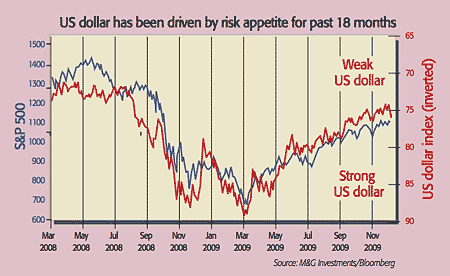
Since early last year, there has been “a rock-solid relationship” between the dollar and risk appetite, says Jennifer Hughes in the Financial Times. Good news would fuel appetite for risk, weakening the dollar as investors sold safe US holdings to scoop up assets such as stocks or commodities. Bad news has prompted the sale of those assets and investors to seek a safe haven in dollars. The inverse correlation between US stocks and the dollar has been above 90% over the past six months (a 100% correlation would imply that the two trends were in lock-step).
Last Friday there was talk that the link might be ending. US employment figures were much better than expected: 11,000 jobs were lost in November, and the jobless rate fell from 10.2% to 10%. The dollar jumped by almost two cents against the euro, as markets brought forward the date they expect an interest rate rise, reversing the trend of falling on good news. If the Federal Reserve does raise rates, it may “dramatically alter the way the US dollar behaves”, says M&G’s Michael Riddell on Bondvigilantes.co.uk. Between early 2004, when the market began to price in a series of Fed rate hikes, and late 2005, the dollar gained almost 12% against the yen and 7% against sterling and 4% against the euro, at a time when stocks were also climbing.
However, on Monday, expectations of rising rates were tempered by Fed chairman Ben Bernanke, who said it was too soon to herald a sustainable recovery. And the risk/dollar relationship stayed intact early this week. A strengthening dollar hit commodities – gold has lost 5% from last week’s peak. Equities fell too, as global jitters on Tuesday prompted investors to seek out a safe haven in dollars. The key to breaking the correlation is to see “consistently improving data” which would shift rate expectations, as Vassili Serebriakov of Wells Fargo points out. But beyond the payroll data, which may well be a one-off, recent releases have been lacklustre. So it’s too early to expect the relationship to end.
The underlying reason for the correlation is the carry trade. Since March, investors have been borrowing in dollars at rock-bottom interest rates and investing the money in higher-yielding, riskier assets overseas. It’s hard to put an exact figure on the carry trade’s impact. But the fact that negative correlations between the dollar and a range of risky asset classes have risen sharply over the past few months suggests that “all assets are driven by the giant dollar carry trade”, says Dean Curnutt of Macro Risk Advisors. Short positions in the dollar are also close to historical extremes, which also points to the influence of the carry trade.
The danger is that a rise in the dollar will trigger a “stampede” as investors rush to cover their short positions by selling risky investments. Cue a sharp, self-reinforcing rise in the dollar and a “co-ordinated collapse” of risky asset classes, as Nouriel Roubini of New York University points out. In short, the dollar carry trade has become a “huge” bubble. And one factor that could drive the rebound in the dollar is the return of the ongoing credit crunch to the spotlight. The latest concern is sovereign debt. But on top of that, the IMF reckons that banks have probably barely written off half their losses, while the global recovery is fragile. So there is ample scope for new shocks. “I would be extremely surprised if we do not see a serious hiccup,” says Philippe Gijsels of Fortis Global Markets. Morever, the US trade deficit is improving rapidly, while the greenback is cheap relative to its long-term trade-weighted average. “The worst days” for the dollar look over, says Capital Economics. But that’s bad news for most other investments.
The big picture: coffee prices will perk up
A rally is brewing in Arabica coffee (the type which accounts for 65%-70% of global consumption), says Maja Wallengren in Barron’s. The International Coffee Organisation notes that demand is growing at 1.5%-2% a year. But thanks to poor harvests in Brazil and Colombia, it expects a supply deficit of seven to nine million bags (60kg) in the year that began in October 2009, compared to a two-million-bag deficit the year before. Meanwhile, stocks have fallen fast and now cover less than two weeks’ demand from importers. Expect prices to keep climbing in the next few months, says Eugen Weinberg of Commerzbank.
Statistic of the week
Britain looks on track to drop out of the world’s top ten economies by 2015, according to the Centre for Economic and Business Research. Over the past four years we have slipped from fourth to seventh, with China and France overtaking us. Strong economic and population growth, rising exchange rates and growing demand for natural resources mean Brazil, Russia and even Canada are set to eclipse us now.